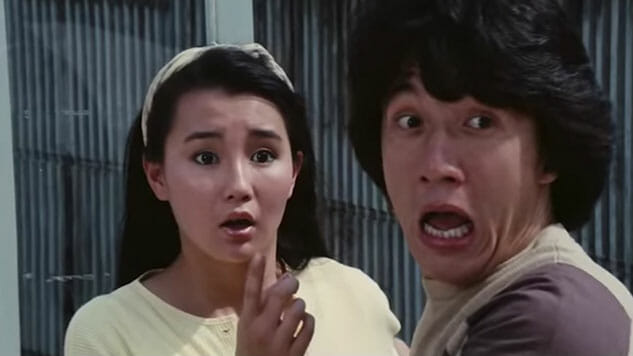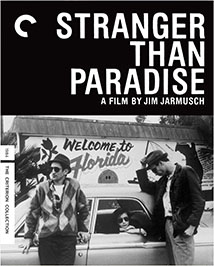
Each month, Paste brings you a look at the best new selections from the Criterion Collection. Much beloved by casual fans and cinephiles alike, Criterion has for over three decades presented special editions of important classic and contemporary films. You can explore the complete collection here. In the meantime, because chances are you may be looking for something to give the discerning (raises pinkie) cinephile this month, find all of our Criterion picks here, check out some of our top titles this April, and, hey, maybe sign up for Criterion’s Criterion Channel, which launched at the beginning of the month.
 Police Story and Police Story 2
Police Story and Police Story 2
Years: 1985; 1988
Director: Jackie Chan
There’s a school of thought that interprets Jackie Chan’s leap from Hong Kong to U.S. superstardom as the beginning of the end of his career—perhaps more specifically his character—as the moment in which all of the things that make Jackie Chan Jackie Chan began decaying as soon as he set foot on Hollywood’s shores. This school is governed by nitwits. Yes, it’s true that Chan has made some spectacularly bad movies working with American movie stars and American movie directors—The Tuxedo, Rush Hour 3, The Spy Next Door, Shanghai Knights—but it’s untrue that these movies are in any way “bad” because they command him to act like a clown. The thing is, acting like a clown is in Chan’s DNA.
With the joint release of Police Story and Police Story 2, Criterion’s put out the best possible set to remind audiences how deep Chan’s proclivities for good old fashioned comic pratfalls run. There is, in fairness, a dividing line between the two. The Three Stooges-level gags that help give Police Story its shape are sadly absent from Police Story 2. At no point in the latter does May (Maggie Cheung) clobber her dopey cop boyfriend Ka-kui (Chan) with a cake, who then gets clobbered by a second cake courtesy of a friend, and then a third cake after scrubbing away all confectionary remnants from his face. (This cake, too, is thrown by May, who appears to keep an arsenal of baked goods around her apartment for the sole purpose of clobbering Ka-kui with them as occasion demands. He brings it on himself.)
Whether that’s a plus in Police Story’s favor or a minus lies in the eye of the beholder. Some will hold Police Story 2 in higher esteem for increased emphasis on action; others will prize Police Story for cake. But both films demonstrate the many particulars that make Jackie Chan who he is, and who’s always been, and who he always will be, as long as he’s still the guy willing to take three cakes to the gob. —Andy Crump
 A Face in the Crowd
A Face in the Crowd
Year: 1957
Director: Elia Kazan
Twenty years before screenwriter Paddy Chayefsky’s Network screamed into a bullhorn about the dangers of mixing entertainment and politics, A Face in the Crowd (penned by Bud Schulberg) blew the first warning whistle while also providing a still painfully relevant indictment of empty populism dependent on a cult of personality. Discovered by an ambitious radio producer named Marcia (Patricia Neal) in an Arkansas prison, the naturally charismatic “Lonesome” Rhodes (Andy Griffith) becomes an overnight sensation with his “tell it like it is attitude” and his unvarnished stage presence, boosting an obviously unquenchable thirst for constant attention and audience approval. Even after he becomes a household name across the nation, Rhodes seeks more power and adulation, resulting in a bid for political power with the full knowledge that his “poorly educated” working class audience, for whom he has nothing but contempt, will do anything he tells them to. Sound familiar?
As Marcia falls in love with Rhodes, she gradually realizes that he only has loyalty and care for one person: himself. Is it too late to stop this narcissistic demagogue she’s created? Director Elia Kazan, known for his surgical precision in constructing three-dimensional characters, creates with Schulberg one of the most complex personalities in Hollywood history, aided tremendously by Griffith, organically tapping into his natural lovability while exposing a lesser-seen darker side in his first film role. At all times, Rhodes is both a tragic figure and a chilling villain.
Criterion does full justice to this classic with a glorious new HD transfer that finds a perfect balance between analog grain and digital clarity. The extras include the expansive making-of documentary from the 2005 DVD release, as well as a new interview with Andy Griffith biographer Evan Dalton Smith. But the real gem here is an interview with Kazan biographer Ron Briley, who intimately dissects how Schulberg and Kazan infamously gave names to McCarthy’s actual witch hunt, yet continued making films with clear progressive agendas. —Oktay Ege Kozak
 Stranger Than Paradise
Stranger Than Paradise
Year: 1984
Director: Jim Jarmusch
Even today, Jim Jarmusch perhaps represents the epitome of Baby Boomer indie auteurs: Everything he’s done has been done before—and he fully admits as much: Look only to the Criterion edition of Stranger Than Paradise to find a guide to watching by the director, which amounts to him listing all the film’s influences—but everything he’s done is inherently his own. Just like his own introduction to this movie, an admission that describing what Stranger Than Paradise is about is a lot harder than describing how the movie feels, it’s much easier to muse on how beautifully Jarmusch’s films synthesize his many muses than it is to articulate how he does that. Jim Jarmusch, then, is a quintessential American director, a man defined by many dead men and a filmmaker irrevocable from many films (his zombie movie is opening Cannes this year), and Stranger Than Paradise (as well as Permanent Vacation, his debut included in Criterion’s edition) acts as his urtext, a melange of slow cinema and neorealism, of Carl Th. Dreyer and John Cassavetes, of Tarkovsky and Bergman and everyone in between—of black humor and existential dread. So it goes with the film’s plot, which barely exists: Professional Nobody Willie (early jarmusch standby John Lurie) and his pal Eddie (Richard Edson) take a liking to Willie’s teenage cousin Eva (Eszter Balint), a Hungarian immigrant just looking to enjoy whatever small wonders the U.S. has to offer. Looting $600 or so from a recent grift, Willie and Eddie “borrow” Eddie’s uncle’s car to drive from NYC to Cleveland to visit Eva, and from there to Florida, just because. About the immigrant’s perspective of America as much as a tale of the untethered floating through a society that ignores its dregs, through much of Stranger Than Paradise, our trio seems on the verge of actually doing something, then not. Staged in black-and-white master shots, vignettes separated by black screen insets, the film is as formally rigorous as it is informally acted, scripted and otherwise experienced—a black comedy and a bleak rebuttal to the decade’s bourgeois class, a too-personal calling card and a small monument of American independent cinema alike. —Dom Sinacola